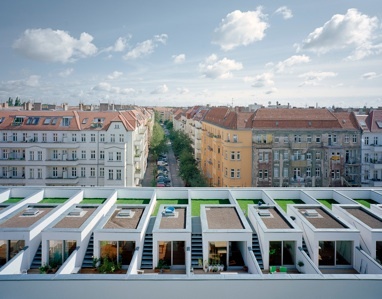
Jan '12 - Mar '12
Our graduate architecture studio traveled to Berlin recently with a specific agenda: to understand modes of architectural agency which fall outside of the traditional role of architecture as a practice. Often architects wait for work to come to them, staying out of the research, financing and management realms of development. It seems that after the economic collapse, architects are more intrigued by alternative ways of engaging in their work, and in Berlin they have been exploring these ideas for a long time.
One such group is Zanderroth Architekten. They have created a highly-articulated collection of living units in Prenzlauer Berg with a surprising relationship between quiet family enclave and strong urban presence along the street. Each unit is narrow, but 4-stories in height, and has a rooftop garden looking down over the street. At the base of each unit there is a room which appears like a storefront, one of the more curious elements of the building. One of the architects mentioned that it was a purposefully in-between space, half public and half private.

(Photo from Zanderroth website: http://www.zanderroth.de/ze511/ze511_3.html)
According to the architects, this level of complexity and interest in urban space was only acheivable because there was no one telling them that the units wouldn't sell. The problem with the speculative development model is that they aim for the middle in an effort not to alienate anyone. The results, as we know, are often mediocre and underwhelming.
BAR Architekten, also in Berlin, followed a similar route. They bought a small urban lot and designed a tall but narrow building (10 stories of interlocking boxes). It is a purposeful combination of retail, living, and office space which is then divided into half owned and half rented units. Their commitment to urban life was a driving force. The project is spoken of in terms of its "internal urbanism which actively contributes to the continuing evolution of the city as meeting place."
These projects are impressive, but they also took long periods of time and a group of clients that were also highly invested in the same social and urban mission that the architects explain. In the end however, the results are impressive. It makes me curious if there are similar models happening in the US. If you have heard of this type of practice occuring in the US, please comment below or send me a message.
View full entry
We're working with a different type of architectural agency this spring. Taking examples from communities who have appropriated space in various ways; either modification of the modernist frame or the literal taking or contestation of space. Below are some examples from our studies... View full entry
This sculptural project was the initial stage in a design studio in the fall of 2011 which focused the locks area of central Stockholm called Slussen. The studio was concerned with urban and architectural issues but the Threshold assignment served as a way to explore notions of boundary, network... View full entry
In Manfredo Tafuri's 'Architecture and Utopia' an inherent opposition is expressed within all modern art as, "those who search the very bowels of reality in order to know and assimilate its values and wretchedness; and those who desire to go beyond reality, who want to construct ex novo new... View full entry
This blog will document areas of discourse and architecture/urban achievements occurring in the master's program at Cornell's AAP in Ithaca, NY. While it will feature many students' work, I would like for it to maintain a discursive focus, illucidating the theoretical objectives of the work occuring here.